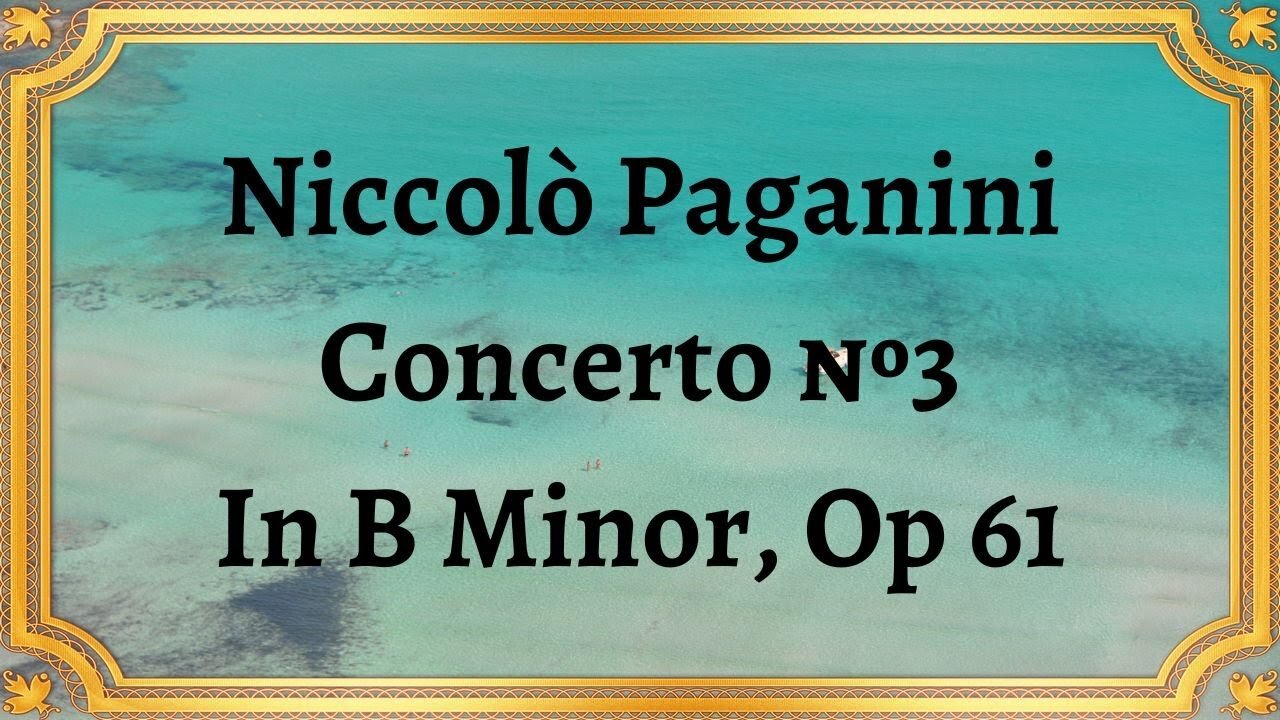Premium Only Content

Niccolò Paganini Concerto №3 In B Minor, Op 61
#NiccoloPaganini #ConcertoNo3 #BMinor #Op61 #ClassicalMusic #Violin #Orchestral #TechnicalBrilliance #InnovativeComposition #VirtuosicPerformance #MusicHistory #MusicalGenius #MusicalMasterpiece #MusicAppreciation #Orchestration #Composition #Concerto #MusicPerformance
Publication date 1950
ZINO FRANCESCATTI, Violin, with THE PHILA- DELPHIA ORCHESTRA, EUGENE ORMANDY, Conductor
Niccolò Paganini is widely regarded as one of the most skilled and innovative musicians of the 19th century. His innovative approach to composition and virtuosic performances on the violin have inspired countless musicians and composers. One of his most famous works is Concerto No. 3 in B Minor, Op. 61, a masterpiece that showcases Paganini's exceptional skills and mastery of the violin.
Paganini's Concerto No. 3 in B Minor, Op. 61, was first performed in 1830 and is considered one of his most significant works. The concerto features three movements, each with distinctive characteristics that showcase Paganini's technical and creative abilities.
The first movement, Allegro maestoso, is characterized by its dramatic opening and confident presentation of the violin's lyricism. It features a soaring melody that showcases Paganini's exceptional technical abilities, precise bowing, and intricate fingerwork. The violinist must navigate the complex phrasing, trills, and arpeggios with precision, making this movement challenging to perform.
The second movement, Adagio espressivo, is a lyrical and emotional piece that provides a welcome contrast to the technical complexity of the first movement. The violin soars over an orchestral accompaniment, creating a heartfelt and emotional sound that highlights Paganini's skills as a composer. The violinist must use slow bowing techniques to create a gentle and emotional sound, drawing the listener's attention to the vibrant melody.
The final movement, Rondo: Allegro molto, is a technically demanding piece that concludes the concerto with a sense of joy and triumph. The movement features technical passages and virtuosic ornamentation that require the violinist to play at a fast pace. The orchestra's rhythmic accompaniment complements the violin's technical brilliance, providing a satisfying conclusion to the concerto.
Paganini's Concerto No. 3 in B Minor, Op. 61, is a masterpiece that highlights his genius as a musician and composer. His technical brilliance is showcased throughout the piece, with complex and intricate writing that challenges the performer's endurance. The piece demonstrates Paganini's innovative approach to composition and performance, with a balance of technicality and expression that has inspired countless musicians and composers. The concerto continues to be a popular piece in the classical music repertoire, standing as
You have the opportunity to support the channel https://destream.net/live/RadSiarAl/donate
-
 LIVE
LIVE
TheCrucible
3 hours agoThe Extravaganza: 6/09/25
14,042 watching -
 LIVE
LIVE
Ark of Grace Ministries
4 hours agoThe Clash: Feuds at the Top, Fire in the Land!
2,198 watching -
 LIVE
LIVE
Untamed Nation
1 hour agoTRUMP SENDING 7000 TROOPS TO WASHINGTON DC FOR “PARADE” ⚠ IS HE ABOUT TO DECLARE MARTIAL LAW⁉ | 9 JUNE 2025
1,200 watching -
 1:26:20
1:26:20
vivafrei
2 hours agoPEACEFUL VIOLENCE IN LOS ANGELES! Canada on the Brink! Some Blake Lively Crap AND MORE!
45.3K17 -
 1:40:24
1:40:24
Redacted News
1 hour agoSenator Ron Johnson: Investigating the towers collapsing on 9/11 & Trump's Big "Immoral" Bill
62.6K54 -
 1:07:37
1:07:37
MTNTOUGH Podcast w/ Dustin Diefenderfer
15 hours agoJohn Doolittle: Navy SEAL’s Secrets to Boost First Responder Mental Health | MTNPOD #119
2.05K -
 LIVE
LIVE
LFA TV
21 hours agoLFA TV ALL DAY STREAM - MONDAY 6/9/25
1,733 watching -
 18:38
18:38
Ohio State Football and Recruiting at Buckeye Huddle
17 hours agoOhio State Recruiting: Buckeyes Land Commitment from Local Star Favour Akih
1.51K -
 54:25
54:25
Kimberly Guilfoyle
5 hours agoIn the Interest of Justice: The Fight for Truth | Ep228
21.1K5 -
 2:12:51
2:12:51
The Quartering
4 hours agoMedia Coverup Of LA Riots, Kash Patel Humiliated On Joe Rogan, Trump To Teach LA A Hard Lesson!
135K54